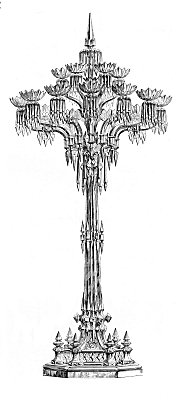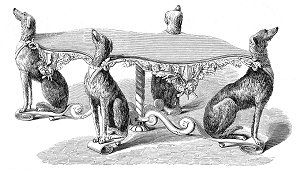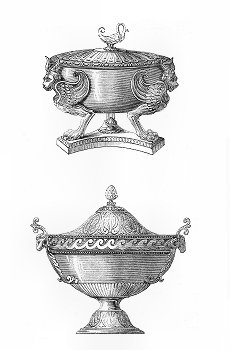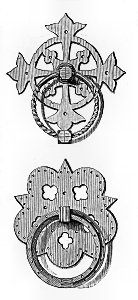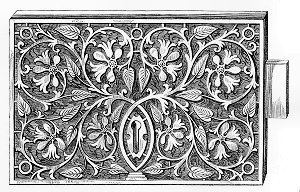|
In 1856 Wallis read a paper to the Royal Society of Arts on “Recent Progress in Design, as applied to Art Manufacture". This paper considers various areas of industry, in most of which Wallis reports that progress had been made in matters of design and good taste. But he prefaces his more specific remarks with some general observations. (The paper also gives us leads as to what design principles Wallis had espoused. I will deal with these another time but some of the illustrations given here will give some idea of his principles).
The prefatory remarks show us that Wallis had a close appreciation of the practicalities of the matter and had gained a wide experience of industry and commerce. On this basis he launches a rather sarcastic attack on those who have not helped forward the cause of industrial design. “It is scarcely to be supposed, however, that everybody is as yet convinced even of the truth of the theory that beauty is as cheap as ugliness.” But progress had been made in the last twenty years and “It has been found, too, that the markets have not stagnated because goods were a little prettier than formerly and it has even been hinted at, though this is looked upon with suspicion as a dangerous commercial heresy, that public instruction in art, by means of lectures, schools of art, art publications, and the free access to galleries of works of art, has had something to do with this change”. But all was not plain sailing: “By the manufacturer popular art was considered as an impertinence, by the connoisseur par excellence, it was regarded as a profanation”.
The shop keepers – who bought from manufacturers and therefore had the power to determine what the general public actually saw and could buy – were a great obstruction to progress and objected to their customers’ being better informed on matters of art and style than they were. “Thus one has sometimes been compelled to listen to a statement how two customers, who had attended a lecture on art the night before, had impudently dared to call the last new design for a chandelier 'a brass gooseberry bush turned upside down'; and, worse still, one has been compelled to father and defend the principle of criticism and declare that the said chandelier was more like an inverted gooseberry bush than anything else in creation”. But Wallis admits that it would be ungenerous and unwise to criticise the manufacturer for not making, and the shop keeper for not stocking, articles which the public are not sufficiently educated in good taste as to buy.
But what of the connoisseur? Wallis devotes some time to this miscreant: “The lover of antiquity who affects ancient types and methods, and believes that all the labour-saving inventions of modern times are so many mechanical abominations, to be repudiated by all earnest and true spirited art-workers, forgets altogether the question of mechanical power is only one of degree, since the hammer, the file and the chasing tool are mechanical contrivances for facilitating labour which could not be executed so well or so speedily by more primitive means. The secret of all this abomination of stamping, electro-depositing printing, power-loom weaving, and so forth, lies, it is to be feared, in the fact that the almost exclusive possession of a work becomes impossible. Duplication spoils that flattering unction which your pure and legitimate connoisseur lays to his soul as to the uniqueness of his treasure. The beauty of a fine work may be a joy to others as well as himself, therefore he loathes the vile, short, cheap and ready process by which this is effected”. And the connoisseur argues too, Wallis thinks, that many reproductions of the same work makes the unique common and is a traitorous use of art. Wallis, of course, thinks that a thing of beauty is a joy for any number of repetitions. In any event, there can only be judgement by results. “It is the complete fact of the work itself with which we have to deal, not whether a man pottered for a month over a piece of work with a hammer and chisel or struck it out at a blow with a die and press”.
This paper had been sent in advance to members who therefore had the opportunity of coming along forewarned and forearmed. At then end of the paper the Chairman observed that not everyone present would agree with what Wallis had said and he particularly requested one member of the audience to give his views – and he called upon Mr. Ruskin. Ruskin seems to have thought that Wallis had been getting at him, personally. He probably got this idea from the fact that Wallis had been getting at him personally. And it is interesting that, even at this early date, Wallis had found the criticisms which were to haunt the arts and crafts school of thought for the rest of the century and beyond, criticism which were never satisfactorily answered and whose strength, it might be thought, was bolstered by the failure of the twentieth century arts and crafts villages. Ruskin, anyway, was prepared to defend three points: that good art should not be cheap; that good art could not be cheap; and that if good art could be made cheap – or, at least, accessible - they were not going the right way about it. He gave his defences of these points but did not make a very convincing job of it at all – but the arguments cannot be considered here, in an article about Wallis not Ruskin. But one further point might be worth taking in further detail. Ruskin complained that he could not understand what principles Wallis was applying in reaching his verdicts on the merits of articles. Ruskin appears to have made this criticism on the basis that Wallis had not applied his implied principles consistently. He pointed out that Wallis argued that an object must be suitable for its purpose; yet he had praised a Palissy ware dish - and nobody could possibly eat off a Pallisy ware dish. Wallis managed to refute this by pointing out that a Pallisy ware dish was not a dish for use but purely for ornament. But one might feel that Ruskin was getting near to another, more general, point: what was Wallis's manifesto? Where was his statement of general principles by which to make a critique of art or objects? At the time people were not unused to manifestos, and when thinking of those times we tend to look for them. And not just manifestos - the more numbered rules there were, the better: it tended to look more scientific. Owen Jones’ Grammar of Ornament was published in 1856, the year of Wallis's paper. It contains 4 “facts” about design and 37 propositions (or general principles), the last of which itself contains a demand for better education in general principles. (Owen Jones here writes only about ornament with no consideration of what it should be applied to and how it should be applied. The nearest he gets to saying anything useful to art manufacture is Proposition 3: “As Architecture, so all works of the Decorative Arts, should possess fitness, proportion, harmony, the result of all which is repose”. What he meant by any of that is not exactly clear). Whether this work had been published before or after Wallis's lecture I do not know and it does not matter much as Wallis would have been well acquainted with Owen Jones and with what would be in the book before it was published. Wallis never published such a book. The criteria by which he made his judgements have, with one exception which I will refer to later, to be deduced from a scatter of places. Wallis is not really to be blamed for this – he was not given to writing easy rules and doubtless, when he was a teacher, his principles were made clear to his students. His principles would not have been significantly different from those espoused by Henry Cole's South Kensington group.
It may also be worth noting here, where it will go just as well as anywhere else, that although Wallis and his like often talk of industrial design, there were limits to what they meant by that - limits which we might not recognise. As the text for this sermon I might take the entry Queen Victoria made in her diary after a visit to the 1851 exhibition. "Went to the machinery part, where we remained two hours, and which is excessively interesting and instructive. ... What used to be done by hand and used to take months is now accomplished in a few instants by the most beautiful machinery." It seems that the Queen would have been on Wallis's side, rather than Ruskin's, when it came to deciding if what is mass produced can also be artistic. But what did Her Majesty mean by "beautiful machinery"? Did she mean that it looked good? Or did she simply think that it was wonderful and therefore beautiful, or that it was beautiful because it produced things? (Had anyone yet written that "who sweeps a room as for Thy laws makes that and the action fine"?) It might also be worth noting that although Wallis and the rest of the Cole group did not expound upon the design of the machinery itself, there were those who were interested in it. Robert Stephenson had said, after the Rocket had proved a success, that it was important to make their next locomotives prettier. He seems to have been thinking in these terms because he had recognised that passenger trains were going to be as important as goods trains and that the engines needed to look more attractive (and less frightening to people as well as horses). He seems to have succeeded, for when the Planet class of engines was produced Isambard Kingdom Brunel is said to have declared that it would be an ornament in any living room. But the appearance of what was inside the factory and out of the public eye was not usually considered to be of importance. I am told by John Tittle, a leading machine tool engineer, that this remained the case with British machine tools until the 1960s, when Italian machine tools started to sell well because they looked good. Wallis himself was insistent that the use of machinery was not relevant to the artistic worth of what it produced: modern machinery was but the old hand tools writ large. But he never seems to have concerned himself with the appearance of these machines. Even when describing a machine in some detail, and praising it working and output, he says nothing about its appearance. And when he, and those with interests like his, spoke of industrial design they did not include the appearance of machines involved in factory production. They might have thought, as was thought long after their time that, in machinery, function was so paramount that the appearance of the form was a necessary result of the function and unalterable. But people took a lot of interest in the external appearance of coffee mills. So when Wallis and the others talk about "industrial design" we modern readers should bear in mind that they are only talking about "art industry", and that they seem to have had in mind not every aspect of industry but only those products of industry which were likely to end up on display in the home or some public place. And, while I am at it, I might as well comment that Wallis (and, so far as I know, most of contemporary art industry gurus) never said much about buildings and their external ornamentation. This is interesting as they certainly saw themselves as having an important contribution to make to interior decoration. And in furniture, for instance, Wallis was clear that the structure or construction of the piece should not be lost under ornamentation. In the mid 19th century there had been a great interest in exposing the structure of buildings - something probably derived from the naked frames of the great railways stations as well as the Crystal Palace, supported maybe by increasing medievalism and an interest in timer framed buildings. The idea did not last long and buildings were decently clothed again. But in furniture design the idea of letting the structure show survived much longer and the urge to cover any plain surface with decoration seems to have been accommodated by insisting that the decoration of each part of the structure should differ sufficiently from that on each other part for the difference between the parts to be apparent. The application of art to buildings should have been of particular interest in the period in which terra cotta ornamentation was the in thing. Many terra cotta panels and tiles would have been designed by the architect of the building they were to go on. But the manufacturers of these things had vast numbers of stock patterns and these would but rarely have been designed by architects. They would have been designed by draftsmen employed by the manufacturer, whatever design training they may have had. Although there do not seem to be specific references to this use of design in Wallis's courses and syllabuses, there is a reference in his address "Decorative Art in Britain" of 1877. Speaking, at the end of his address, about "the revival of architectural taste in England" he says: "Manchester had something to do with this revival so far back as 1845 to 1850, and although an Italian palace is not the best possible model on which to build the facade of a Manchester warehouse, large sums of money were spent on external decorations, which gave an immense impetus and great encouragement to the practice of decorative stone caving, which has borne good fruits in these later years; for without this encouragement, many able works would never have been executed for want of skill in the stone carver to work out the details". It may be significant that of the 220 students enrolled at the Manchester School of Design in 1845, there was one marble mason and one stone mason. In the Journal of the Society of
Arts in 1856 Wallis wrote about the japanning industry, in which
Wolverhampton was heavily involved and in which he himself had worked:
“The facile power of hand displayed by our Japanners is often
very great, but this is too frequently directed by nothing more that the
merest tradition of the workshop.
The inventive power too, of some of the most talented is also very
great;
but being undisciplined by knowledge of the laws which govern
composition in ornament, they are rather the producers of clever
accidents in arrangement, than designers in the full sense of the term”.
It may be significant that the largest firm of japanners in
Wolverhampton in the second half of the nineteenth century was Henry
Loveridge & Co., and that Henry Loveridge was, for many years, chairman
of the Art School; and he also wrote about the need for art education. But it is interesting to note here
that Wallis, like many of his contemporary critics, was full of praise
for the work that was coming out of India and other eastern parts.
At one point Wallis comments that all the workers there seem to be
natural designers. But neither he nor his contemporaries seem to
see the significance of this. They never thought to investigate
the art schools of India that must have been producing these designers -
probably because there weren't any. Even the Moghul miniaturists
trained new painters by the system of "sitting next to Nelly" and it is
not clear whether the textile designers did even that. But one way
or another they were all doing no more than following "the merest
tradition of the workshop".
|
